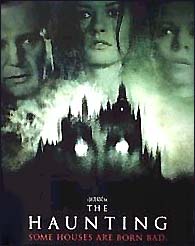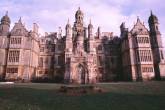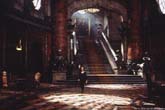Interview
with Sound Designer Gary Rydstrom
 When
Hill House, the monstrous, lonely setting of Shirley Jackson's
1959 novel "The Haunting of Hill House," greets its newest tenants,
it is not with a welcome mat. "Around them the house steadied and
located them," Jackson wrote, "and small eddies of air and sound
and movement stirred and waited and whispered." When
Hill House, the monstrous, lonely setting of Shirley Jackson's
1959 novel "The Haunting of Hill House," greets its newest tenants,
it is not with a welcome mat. "Around them the house steadied and
located them," Jackson wrote, "and small eddies of air and sound
and movement stirred and waited and whispered."
A
team of psychic investigators have come to test the mansion's
reputation as a haven for supernatural phenomena, but it is they,
not the ghosts, who are being measured. "The Haunting," directed
by Jan De Bont, is the second film adaptation of Jackson's novel
(Robert Wise directed a 1963 version), and once again Hill House
is meant to sound as frightening as it looks.
From
its eerie opening scenes, "The Haunting," set to open on July
23, is layered with the sounds of inhuman conversations -- between
wood and air, between stone and glass, and between an evil entity
and its tormented victims. But only a few weeks ago, Hill House's
awakening was not yet complete.
On
a recording soundstage here at George Lucas' Skywalker Ranch,
the movie's sound designer, Gary Rydstrom, had just received an
urgent call from a colleague. An image of the movie's fragile
heroine, played by Lili Taylor, was frozen on a movie screen and
on two video monitors. Rydstrom and his two assistants looked
almost as tense as the actress, who was cowering in bed, her eyes
fixed on something on the ornately carved ceiling.
"That's
where the visual effect goes,' said Rydstrom, advancing the
film a few frames. "They've just added something new to it, so
we have to come up with an additional sound effect." Though
the art of sound is often viewed as the last and hastiest
element of movie production, Rydstrom has had two months to prepare,
an unusually long time. For a suspense film about largely unseen
forces, evocative sound is essential to the movie's success.
"We
had to find a way to give the house a voice, even before we
began shooting," said De Bont. "Normally, actors would be reacting
to the director, who's saying things like: 'Now you hear a footstep!
Now you hear a door creaking!' And that's horrible for them. They
don't know where the sound is coming from, where it's going, or
what it will eventually sound like in the movie. But if you can
fix it for them there on the set, you get fantastic reactions."
Soon
after "The Haunting" was green-lighted by Dreamworks, De Bont
took steps to insure that its actors (including Liam Neeson and
Catherine Zeta-Jones) could react not merely to one another but
to an invisible cast of thousands. His first choice for the job
was Rydstrom, 40, who has shared seven Academy Awards for sound
design and sound effects editing, most recently for "Saving Private
Ryan." Rydstrom's
resume is diverse. It includes "Star Wars: Episode I -- The Phantom
Menace," "Titanic," "The Horse Whisperer," "Jurassic Park" and
"Terminator 2: Judgement Day." But he had done the sound for only
one ghost movie, and that was the G-rated "Casper."
"
'Casper' was a friendly ghost; this was going to be different,"
Rydstrom said. "To me, a scary sound is one that you can't pin
down, or one that is behind you. Something we use a lot is the
sense of space, the ghostly movements. The sounds spin around
the room in a strange way. The movie is full of atmosphere and
ambiences that have little whispery sounds. You're always becoming
attuned to these things that might be a distant voice in the wind."
 Inspired
by the script and by preliminary drawings by the film's production
designer, Eugenio Zanetti, Rydstrom recorded -- and then distorted
-- the sounds that would emanate from a place that Jackson called
"a masterpiece of architectural misdirection." (Exteriors were
filmed at Harlaxton Manor near Lincolnshire, England, a Gothic-Jacobean-Baroque
building; interiors were built near Los Angeles. Inspired
by the script and by preliminary drawings by the film's production
designer, Eugenio Zanetti, Rydstrom recorded -- and then distorted
-- the sounds that would emanate from a place that Jackson called
"a masterpiece of architectural misdirection." (Exteriors were
filmed at Harlaxton Manor near Lincolnshire, England, a Gothic-Jacobean-Baroque
building; interiors were built near Los Angeles.
To
insure a fresh approach, Rydstrom and his associates searched
for new variations on the sounds that audiences associate with
haunted houses. After that, he said, the biggest challenge was
to come up with names for each sample. (The results, indexed on
a computer, sound like a record company roster: Buzzmoan-ambience,
Rumble-wave, Demon speed-by, Dreaded-booms, Thunder-switch.)
The
team's one concession to movie tradition, he said, was to
record a magnificently creaky door that he found in the cellar
of a Northern California winery. He also happened to have extensive
recordings made inside an old hotel near Glacier National Park
in Montana, where Rydstrom and his wife were stranded during a
June snowstorm several years ago.
"I
spent three days recording gusting winds through the cracks of
windows and doors, so that came in handy," he said. "It sounds
as though the wind has a child's voice inside it -- a little screaming,
whispering human being in it."
The
first sound the audience will hear upon entering Hill House,
however, is a slow, booming, rhythmic breathing. "When the front
door opens for the first time, there's also a sort of exhalation,
an airy sound that takes you into the house," Rydstrom said.
To
capture that sound, he set up a digital recorder in his Saab Turbo
and risked becoming a ghost himself. "If you drive about 80 miles
an hour on the freeway and open your sunroof, you get a great
'bwaaa!' sound," he said. "It was dangerous, so I did it late
at night so there was no one around to hit."
But
it was the booming sounds, not the breathing, that proved
to be most impressive. During the filming, De Bont operated a
digital audio player and used about 100 of Rydstrom's sounds to
inspire and surprise the actors. Ms. Taylor said that the sound
cues had provided an integral part of her performance.
"Shrill
screaming, strange wild banging, children calling me lightly --
all sorts of noises," she said. "One time in England, when Jan
didn't have the sound machine, he started making sounds with pots
and pans for us. I loved that."
 The
most unnerving sound effects, Ms. Taylor said, were those
that suggest a huge, unseen presence moving overhead. "It was
low, reverberating, eerie sound," she said, "like a giant sliding
its feet, with a little noise in between the slides." The
most unnerving sound effects, Ms. Taylor said, were those
that suggest a huge, unseen presence moving overhead. "It was
low, reverberating, eerie sound," she said, "like a giant sliding
its feet, with a little noise in between the slides."
The
dragging sound, Rydstrom said, was derived from a recording
of a 19th-century iron lung that he found in a San Francisco museum.
"We slowed down the mechanical sound, and it turned into a rhythmic
sweep-clunk, sweep-clunk," he said. The sounds of rapping, booms
and crashes came from some energetic recording sessions at several
Bay Area houses, all abandoned and set for demolition.
"We
went in there with baseball bats and smashed the hell out of walls
and doors," he said. "But for the final mix, we almost always
ended up using a sweetener of some distant explosion or artillery
sound."
Despite
the pyrotechnics, Rydstrom believes that "sound is all about
emotion, the way music is emotion."
"We
don't quite understand why rhythm and pitch and frequency stir
us emotionally, but they do," he said. "It would be hard to write
a textbook and say: With a certain pitch or frequency, you will
get a certain reaction in the listener. So a lot of sound work
is to take a guess and continually gauge your own reaction.
"One
of the great compliments I've ever heard was from a man who
told me that his son loved to watch 'Jurassic Park,' but he was
too frightened so he'd turn the sound off and watch. Without the
sound, it was no longer scary to him, but he still loved it. It
was good to know that that's where the scariness came from."
>>
Read about Gary Rystrom
You can order "The Haunting" from Amazon.com...
- DVD
Region 1 encoding (US
and Canada only)
- VHS
NTSC format (US and
Canada only)
Site
Map
|